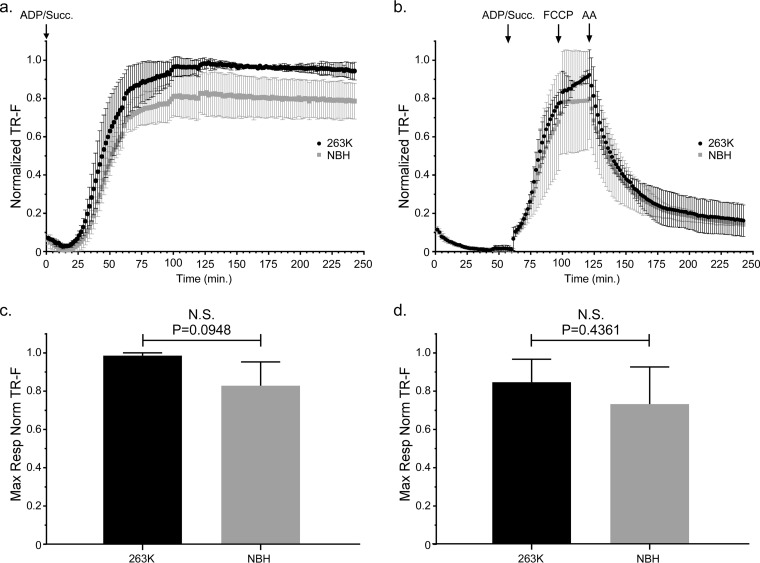FIG 2.
Mitochondrial oxygen consumption is unaltered in 263K prion-infected Tg7 mice at the midpoint of prion disease incubation. Isolated brain mitochondria from Tg7NBH and Tg7Sc mice euthanized at 20 dpi were assayed for their ability to take up oxygen in response to the complex II substrate succinate. (a) Saturating concentrations of ADP and succinate were added to each well at the beginning of the assay (arrow at 0 min, ADP/Succ.). A single Tg7Sc and Tg7NBH brain was assayed in each experiment. For each individual experiment (n = 3), fluorescence intensity was normalized to the maximum fluorescence value of the oxygen reactive probe MitoXpress within that experiment. Error bars represent the normalized standard deviations for each time point. (b) Isolated brain mitochondria from Tg7NBH and Tg7Sc mice were allowed to equilibrate in the absence of substrate in order to obtain a basal level of oxygen uptake. Saturating concentrations of ADP and succinate (arrow at 60 min. ADP/Succ.) were added to wells containing mitochondria. The proton ionophore and oxidative phosphorylation uncoupler FCCP was then added to each well containing isolated mitochondria (arrow at 115 min, FCCP) to obtain maximal uncoupled respiratory rates. Lastly, the complex III inhibitor antimycin A was added (arrow at 135 min) to shut down electron transport. Data were normalized as for panel a. (c) Maximal respiration for panel a was determined by comparing the mean of the maximal values for each normalized value. (d) Maximal respiration for panel b was determined by comparing the mean of the maximal values for each normalized value. For panels c and d, an unpaired two-tailed Student t test was performed to determine significance. The normalized mean is derived from the average of 3 technical replicates for 3 experimental animals. TR-F, time-resolved fluorescence; N.S., not significant.

